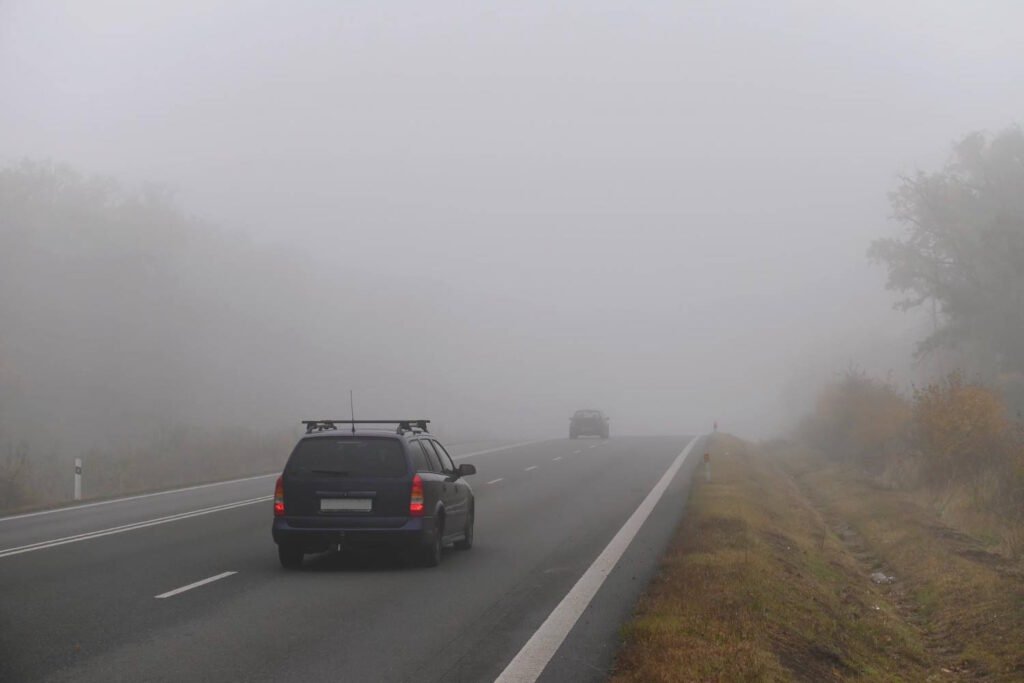The open road offers freedom and adventure, but Mother Nature often has other plans. From sudden downpours to blinding snowstorms, weather can transform a routine drive into a test of skill and patience. In the United States, where weather patterns vary dramatically from the foggy Pacific Northwest to the hurricane-prone Gulf Coast, understanding how to navigate challenging conditions is essential for every driver.
According to the Texas Department of Insurance, a motor vehicle crash occurs on Texas roads approximately every 56 seconds, with over 10% of these accidents nearly 60,000 crashes attributed to poor weather conditions. These sobering statistics highlight why preparation and proper driving techniques are crucial when facing adverse weather.
Driving In The Rain

when driving in rain the road becomes the most slippery: even experienced drivers must exercise caution. In fact, rain accounts for more than 85% of weather-related roadway crashes in Texas alone, according to the Texas Department of Insurance. Before the rainy season arrives, inspect your windshield wipers. If they leave streaks or skip across the glass, it’s time for replacements. Your tires should have tread depth of at least 2/32 of an inch to effectively channel water away and prevent hydroplaning.
When raindrops begin to patter on your windshield, immediately reduce your speed. As veteran truck driver Mike Hansen from Minneapolis puts it, “Posted speed limits are like fair-weather friends. They’re only reliable when conditions are perfect.”
The Federal Motor Carrier Safety Administration advises reducing your speed by a third in bad weather. In rain, the stopping distance increases significantly, so extend your following distance to 5-6 seconds between vehicles, as recommended by the American Automobile Association, doubling the cushion suggested during normal driving.
Remember to switch on your headlights when driving in rain. This isn’t just for your visibility but to make your vehicle visible to others. In fact, 39 states require headlight use when wipers are active, according to the American Automobile Association.
The first 15 minutes of rainfall are often the most treacherous. During dry periods, oil and grime accumulate on road surfaces. When rain first falls, these substances create a slick film before eventually washing away. Think of it as nature’s version of a slip-and-slide on asphalt.
If you encounter standing water, ease off the accelerator before reaching it. Should your car begin to hydroplane (when tires lose contact with the road), resist the urge to slam on brakes. Instead, gently ease off the gas while holding the steering wheel steady until your tires reconnect with the pavement.
Understanding and Managing Hydroplaning
Hydroplaning occurs when water builds up faster than your vehicle’s weight can push it away. The water pressure causes your vehicle to rise and slide on a thin layer of water between the tires and road, putting you in danger of skidding or drifting out of your lane.
Three main factors contribute to hydroplaning:
- Vehicle speed: As your vehicle’s speed increases, tire traction and control decrease. Always reduce speed in wet weather.
- Water depth: The deeper the water, the sooner your tires lose traction. Even thin water layers at low speeds can cause loss of traction.
- Tire tread depth: The National Highway Traffic Safety Administration recommends checking tire tread depth with a gauge at least once a month.
If you find yourself hydroplaning, follow these steps:
- Step off the accelerator until the vehicle slows and tire traction returns
- Turn in the direction of the skid (although it may seem counterintuitive)
- Wait to feel the tires reconnect with the road surface
- Brake gently as needed (normally if you have anti-lock brakes; pump gently if in an older vehicle without ABS)
Winter Driving Techniques

Winter transforms the driving landscape, requiring both mental and physical preparation. While some regions of the United States experience severe winter weather more frequently than others, even states like Texas occasionally face sleet, snow, and ice storms that make roadways hazardous and unpredictable.
Before winter arrives, winterize your vehicle by checking that your antifreeze, windshield washer fluid, and oil are appropriate for winter conditions. Inspect your battery, wipers, ignition system, thermostat, headlights, hazard lights, exhaust system, heater, brakes, defroster, and tires to ensure they’re properly maintained. Keep your gas tank full to prevent fuel line freezing.
Assemble an emergency kit including a blanket, flashlight, shovel, ice scraper, and sand or cat litter for emergency traction. In northern states like Minnesota and Michigan, many drivers install dedicated snow tires, which provide 50% more traction than all-season tires according to Consumer Reports testing.
Before departing on snowy days, completely clear snow and ice from all windows, mirrors, lights, and your vehicle’s roof. Snow left on top can create a “white-out” effect for drivers behind you when it blows off, or it can slide forward onto your windshield when you brake.
On snow-covered or icy roads, your vehicle behaves differently. Imagine trying to run across a frozen pond in smooth-soled shoes. That’s essentially what your car is attempting on ice with standard tires. Reduce speed significantly and extend following distance to 8-10 seconds.
When driving in these conditions, smooth and gradual is the mantra. Accelerate gently, brake softly, and steer with deliberate movements. If you begin to skid:
- Stop accelerating (remove your foot from the accelerator to stop wheel spinning)
- Don’t slam on the brakes (gently pump them instead)
- Steer in the opposite direction of the skid to correct your vehicle’s position
- Avoid oversteering, which can cause loss of control
Be particularly cautious on bridges, overpasses, and shaded areas. These structures freeze before regular roadways because cold air circulates both above and below them. As one state patrol officer explains, “Bridges are like popsicles sticking out of the road. They freeze faster and stay frozen longer.”
Be aware of black ice (what is black ice), a thin, transparent layer of ice on roadways that can cause drivers to quickly lose control. Watch the road ahead and try to avoid driving over areas that look slick. If you become stranded, stay in your vehicle, use your cell phone to call for help, and wait for assistance to arrive.
When Driving In Fog You Should

Fog creates some of the most challenging driving environments, equivalent to trying to find your way through a cloud that’s settled on the ground. In Texas alone, fog contributed to 193 crashes and 72 deaths in 2019, according to the Texas Department of Insurance. When fog thickens, slow down significantly and switch to low-beam headlights. Contrary to intuition, high beams make visibility worse as they reflect off the fog particles back into your eyes.
When fog decreases visibility to 0.25 miles or less, it’s considered “heavy fog,” and local National Weather Service offices will issue a Dense Fog Advisory. In these conditions, turn on your emergency flashers to make your vehicle more visible to drivers approaching from behind. When driving in fog you can see better by using the right edge of the road or fog line as your guide to help keep your vehicle in its lane and protect you from the glare of oncoming headlights.
Avoid changing lanes or passing vehicles when visibility is compromised. If fog becomes too dense to drive safely, pull completely off the roadway to a safe location like a rest area or truck stop if possible. Turn on your hazard lights, and wait until conditions improve.
Driving in High Winds

Strong winds can push vehicles around like autumn leaves, particularly high-profile ones such as trucks, SUVs, and vans. Keep both hands firmly on the wheel when driving in windy conditions and reduce your speed to maintain better control.
Be especially alert when passing large vehicles or transitioning from protected areas to open terrain. Picture the difference between standing in a dense forest during a windstorm versus standing in an open field. The same principle applies when you drive from a sheltered area into open exposure.
Watch for debris that may have blown onto the roadway, particularly on rural highways following storms. In states like Kansas and Oklahoma, where open plains allow wind to build tremendous force, drivers sometimes encounter unexpected obstacles from tumbleweeds to displaced construction materials.
Driving In Hot Weather

Summer heat brings its own set of challenges. In southwestern states like Arizona, where pavement temperatures can exceed 150°F during heat waves, vehicle systems face extreme stress. Have your cooling system checked regularly and ensure your engine has the proper amount of coolant.
Check tire pressure when tires are cold, as heat increases pressure and can lead to blowouts. The Arizona Department of Transportation recommends carrying at least one gallon of water per person in your vehicle during summer travel.
Watch for signs of vehicle overheating, such as rising temperature gauges or steam from under the hood. Be wary of pavement softening or buckling on extremely hot days, particularly on older asphalt roads.
Never leave children or pets in parked cars, even briefly. Interior temperatures can rise approximately 20 degrees in just 10 minutes, according to the National Weather Service, creating potentially fatal conditions.
Nighttime Driving

Darkness reduces visibility dramatically, requiring additional vigilance. Ensure your headlights are properly aimed and clean. Keep your windshield clean both inside and out to reduce glare, which can be particularly problematic when facing oncoming traffic.
Reduce your speed according to visibility conditions. You should be able to stop within the distance illuminated by your headlights. When facing oncoming traffic at night, look slightly toward the right edge of the road to avoid temporary blindness from headlight glare.
Fatigue compounds the dangers of night driving. According to the National Sleep Foundation, driving after being awake for 18 hours is comparable to having a blood alcohol content of 0.05%. If you feel drowsy, pull over at a safe location and rest rather than risking falling asleep at the wheel.
Universal Weather Wisdom
Whatever weather challenges you face, certain principles always apply. The Texas Department of Insurance recommends these universal safety tips for all weather conditions:
- Plan ahead: Check forecasts before traveling and allow extra time to reach your destination in adverse conditions. For longer trips, share your route and expected arrival time with someone.
- Slow down: Driving slower helps decrease skids and accidents and makes it easier to avoid obstacles on the roadway.
- Maintain space: Leave more room to stop, especially in bad weather when brake time is slower.
- Use turn signals early: Give plenty of notice to other drivers before slowing down to make a turn.
- Stay informed: Listen to local weather radio at a low volume to remain aware of road conditions and closures.
- Buckle up: Wearing seatbelts saves lives, especially in adverse weather conditions.
- Turn off cruise control: The uncertainty of road conditions during bad weather requires that drivers remain in full control.
- Brake gently: Remove your foot from the accelerator and lightly brake to stop rather than braking hard.
- Avoid quick maneuvers: Sudden turns or lane changes can lead to skids and accidents.
- Pull over when necessary: If conditions worsen significantly, find a safe spot to wait out the storm.
Always wear your seatbelt and avoid distractions. According to the National Highway Traffic Safety Administration, sending or reading a text takes your eyes off the road for about 5 seconds. At 55 mph, that’s like driving the length of a football field with your eyes closed.
Remember that all state laws require drivers to adapt their speed to current conditions, regardless of posted limits. As one driving safety expert puts it, “The speed limit is the maximum under ideal conditions, not a target to hit regardless of weather.”
The next time you encounter challenging weather on America’s roadways, remember that patience is more than a virtue, it might be your best safety feature. By adjusting your driving to match conditions, you’re not just avoiding accidents. You’re demonstrating responsibility for everyone sharing the road with you.
Regional Weather Alerts and Awareness
Staying informed about weather conditions before and during your trip is essential for safe travel. Weather systems can develop quickly and vary dramatically by region.
Freezing rain and hazardous driving conditions expected in South Carolina requires particular attention from motorists in the Southeast during winter months. While the Palmetto State may not experience the same frequency of winter storms as northern regions, ice storms can be especially dangerous because residents may have less experience driving in these conditions and local infrastructure isn’t always prepared to handle ice accumulation on roadways.
The southeastern United States presents unique challenges, as winter precipitation often hovers around the freezing mark, creating a treacherous mix of rain, sleet, and ice rather than just snow. This makes road conditions particularly unpredictable, as surfaces can appear merely wet while actually being coated with nearly invisible ice.
During winter weather events across the country, local National Weather Service offices issue outlooks, advisories, watches, and warnings to help drivers prepare:
- Outlooks are issued before a winter storm watch when forecasters believe winter storm conditions may develop
- Advisories indicate winter weather elements that aren’t expected to be hazardous enough to meet warning criteria
- Watches (usually issued 24-36 hours in advance) signal favorable conditions for significant, hazardous winter weather
- Warnings indicate significant, hazardous winter weather is occurring or imminent and poses a threat to life or property
Before traveling in any adverse weather conditions, check forecasts from the National Weather Service and state transportation departments, or tune in to local radio or television broadcasts. Many states also offer real-time traffic information through dedicated websites and mobile apps, which can alert you to accidents, road closures, or hazardous conditions along your planned route.


